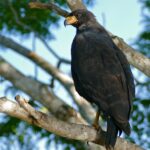Great black hawks, like other birds of prey, do not have the ability to turn their heads a full 360 degrees. This misconception likely arises from the impressive range of motion these birds do have, which is around 270 degrees for owls and even less for other raptors. This is still a significant range, and it allows them to scan their surroundings for prey or threats without needing to move their entire bodies.
The Flexibility of Great Black Hawk Necks
The flexibility of their necks is a crucial adaptation, as birds of prey cannot move their eyes within their sockets like humans can. Instead, they must turn their heads to change their field of vision. This is made possible by the fact that birds have more cervical vertebrae than mammals, including humans, do. While humans have seven cervical vertebrae, birds can have up to 25, depending on the species.
Great black hawks, like other raptors, have powerful eyes that are adapted for hunting. Their eyes are large in proportion to their head size, and they have a high density of photoreceptor cells, which allows them to see clearly even in low light conditions. However, their eyes are relatively immobile, which is why they rely on their neck flexibility to scan their environment.
The Range of Motion in Great Black Hawks
 Image source: Great Black Hawk by Bernard DUPONT
Image source: Great Black Hawk by Bernard DUPONT
While great black hawks cannot turn their heads a full 360 degrees, they do have an impressive range of neck motion. Owls, for example, can turn their heads around 270 degrees, while other raptors have a slightly smaller range of motion. This allows them to effectively survey their surroundings for prey or potential threats.
The table below shows the approximate range of motion for different bird species:
| Species | Range of Motion |
|---|---|
| Owls | 270 degrees |
| Hawks | 180-220 degrees |
| Falcons | 180-200 degrees |
| Eagles | 180-200 degrees |
As you can see, the great black hawk’s range of motion falls within the typical range for other birds of prey, but it is still significantly less than a full 360 degrees.
Adaptations for Hunting
The impressive neck flexibility of great black hawks and other raptors is a crucial adaptation for their hunting behavior. By being able to turn their heads and scan their surroundings, they can effectively locate and track their prey, even in low light conditions.
In addition to their neck flexibility, great black hawks have other adaptations that make them successful hunters:
- Powerful Eyes: As mentioned earlier, great black hawks have large eyes with a high density of photoreceptor cells, allowing them to see clearly even in low light conditions.
- Sharp Talons: Great black hawks have sharp, curved talons that they use to grasp and kill their prey.
- Keen Senses: In addition to their excellent vision, great black hawks have a keen sense of hearing and smell, which they use to locate and track their prey.
Conclusion
In conclusion, while great black hawks and other birds of prey cannot turn their heads a full 360 degrees, they do have an impressive range of neck motion that allows them to effectively survey their surroundings and hunt their prey. This, combined with their powerful eyes, sharp talons, and keen senses, makes them formidable predators in their natural habitats.
References:
– Daily Motion Video
– The Peregrine Fund – Keen Vision
– Reddit – Hawk Head Stabilization
– Reddit – Why Can Many Birds of Prey Rotate Their Head 360?
– YouTube Video


